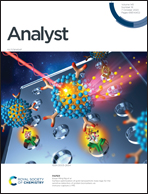A differential study on oxidized/reduced ascorbic acid induced tumor cells’ apoptosis under hypoxia†
Abstract
The anticancer mechanism for reduced/oxidized ascorbic acid (AA/DHA) is of great significance for clinical cancer therapies. A pH controlled fluorescent nanocarrier was designed to targetably deliver AA and DHA into tumor cells for investigating their function in inducing intracellular apoptosis pathways. A fluorescent silicon nanoparticle with polymer coating serves as the pH controlled nanocarrier to deliver AA or DHA into HepG2 and B16-F10 cells for studying their biological functions. The intracellular apoptotic pathway was monitored through the Caspase-3 nanoprobe, while the changes of signal molecules H2O2 and NAD(P)H in the redox homeostasis system were monitored through the corresponding fluorescent probes. Under hypoxic conditions, AA can scavenge H2O2 in tumor cells and promote NAD(P)H accumulation, but DHA promotes the production of both H2O2 and NAD(P)H, indicating that the molecular mechanisms for inducing cancer cells’ apoptosis are significantly different. AA leads to reductive stress by promoting the accumulation of NAD(P)H in tumor cells, but DHA enhances oxidative stress by increasing the H2O2 concentration in cells.



 Please wait while we load your content...
Please wait while we load your content...